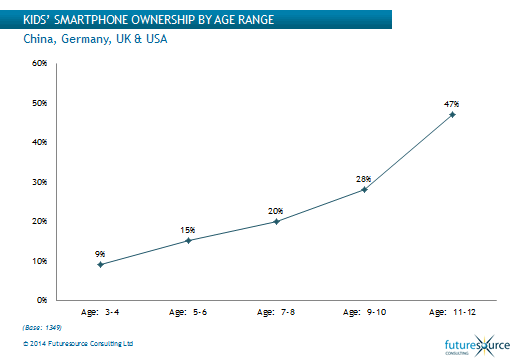It’s easy to get carried away with the idea that the increased availability of technology, broadcast programming and digital content has radically changed the make-up of children’s playtime and altered overall habits for device usage and media consumption. Although this is true in some respects, many of the conventional pastimes of children – sports, reading and traditional games such as board games, jigsaws, construction toys and dolls, still represent an important aspect of many children’s free-time.
UK-based research firm Futuresource Consulting recently completed its second wave of consumer research focused on children age three to twelve across China, Germany, UK and the USA. Over 100 questions were asked, to gather insight and trends concerning children’s interaction with new media, activity time, education and entertainment consumption.

Device Ownership
According to the study, tablet devices have overtaken the Nintendo 3DS as the most popular personal device owned by children in the UK, with 44% of children aged three to twelve owning one. This is even high among the youngest three to four age group (30%). Despite the already high levels of penetration, parents indicated that tablets (including both adult and dedicated children’s devices) were the most likely items to be purchased for their children within the next six months; more than twice as likely to be purchased than smartphones and the latest generation games consoles.
From the age of nine upwards smartphones become more popular among UK children, with 25% of all nine to ten year olds owning one; by age eleven to twelve this has risen to 46%. Within the eleven to twelve age group, ownership by girls reaches 53%, much higher when compared to boys (38%). Such ownership is resulting in ongoing spend for parents with close to 17% of parents spending upwards of £100 a year on mobile subscriptions for their children.
Playtime
Reading books is the most frequently undertaken activity by children, with 45% doing this every day across the four countries combined. When including reading a minimum of twice per week, this percentage goes up to 76%. Beyond playing sports – which is undertaken by 72% of children at least twice a week – traditional board games and jigsaw puzzles remain a key playtime activity with 37% of children participating a minimum of two to three times per week.
In the UK, 39% of children are currently spending five or more hours a week playing board games and jigsaw puzzles, this compares to 63% of children playing with traditional toys (e.g. construction sets, dolls, action figures). Despite the rise in device ownership, time spent on PC/console gaming is still lower than traditional toys (five or more hours = 54%), however this does start to change in the older age groups with 63% of age eleven to twelve boys playing console/PC games for five or more hours per week.
There’s no doubt that technology and digital content is here to stay and continues to exert its influence upon children’s behaviours. However, traditional playtime activities continue to play an important role in childhood pursuits and should not be overlooked.


